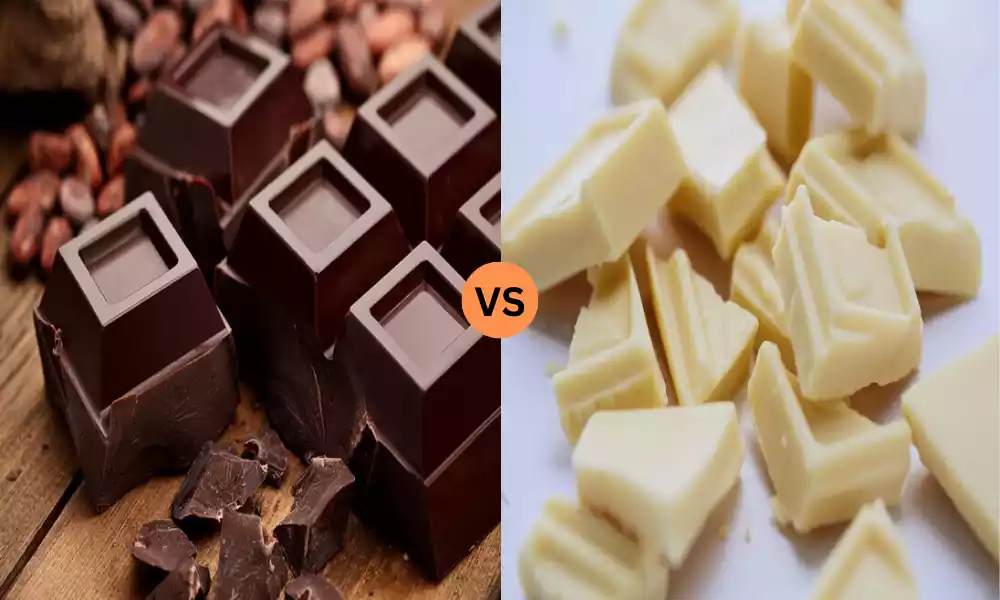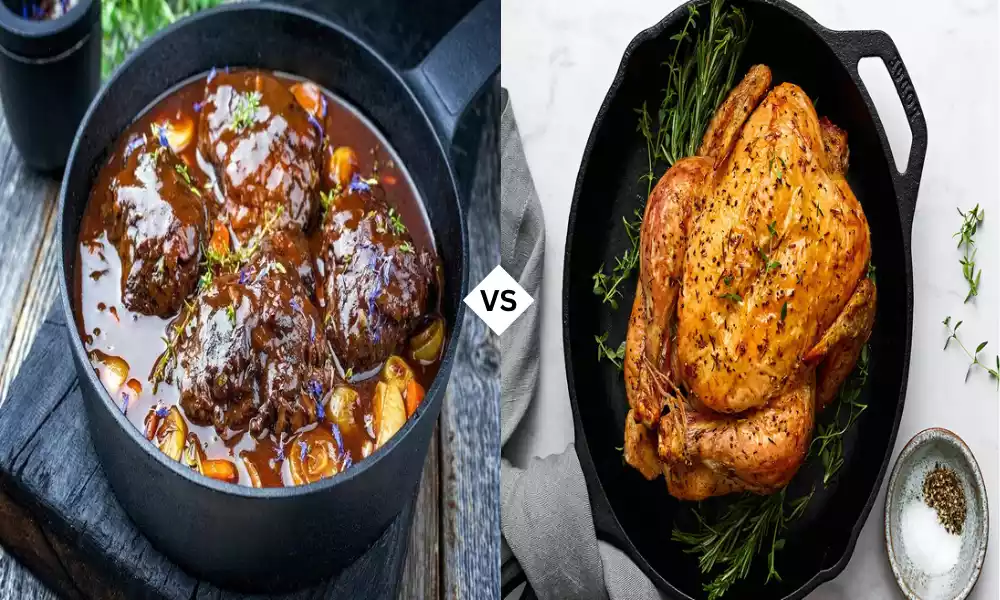Dark chocolate and white chocolate are distinct varieties of chocolate, each offering unique flavors and textures. Dark chocolate, made from cocoa solids, cocoa butter, and sugar, is known for its rich, intense flavor and high antioxidant content. It typically contains a higher percentage of cocoa, lending it a bitter yet deep and complex taste.
White chocolate, on the other hand, is made from cocoa butter, sugar, and milk solids, giving it a creamy, sweet profile. Lacking cocoa solids, it has a milder, smoother flavor compared to its darker counterpart.
Definition of Dark Chocolate
Dark chocolate is a type of chocolate that contains a higher percentage of cocoa solids and cocoa butter than milk chocolate, along with sugar and, typically, a small amount of emulsifiers like soy lecithin to preserve texture. Unlike milk chocolate, it does not contain any milk solids.

The percentage of cocoa in dark chocolate can vary greatly – from 50% to 99% – affecting its taste and texture. Generally, the higher the cocoa content, the more bitter and less sweet the chocolate will be.
Dark chocolate is known for its rich, intense flavor and is often considered a healthier option compared to milk or white chocolate due to its higher concentration of antioxidants and lower sugar content.
Definition of White Chocolate
White chocolate is a sweet confection made primarily from cocoa butter, sugar, and milk solids. Unlike dark or milk chocolate, it doesn’t contain cocoa solids, which are responsible for the characteristic chocolate flavor and color.

The cocoa butter, which is a pale-yellow edible vegetable fat extracted from cocoa beans, gives white chocolate its creamy texture and mild, sweet taste. The addition of milk solids contributes to its smooth, rich mouthfeel.
White chocolate typically has a delicate, buttery flavor profile, often enriched with vanilla or other flavorings. It’s popular in a variety of desserts and confections and is known for its melt-in-the-mouth quality.
Origins and History
The origins and history of chocolate trace back to ancient Mesoamerica, where the cacao tree is native. The Olmecs, one of the earliest civilizations in Latin America, were probably the first to cultivate cacao as early as 1500 BC.
The Mayans and Aztecs later prized the cacao bean, using it to make a bitter beverage called ‘xocoatl,’ often flavored with spices and chili. Cacao beans were so valued that they were even used as currency.
Chocolate as we know it began to evolve after the Spanish conquest of the Aztecs in the 16th century when cacao was brought to Europe. Initially an exclusive luxury for the elite, chocolate was consumed as a drink.
It wasn’t until the Industrial Revolution that innovations allowed for the mass production of chocolate bars. The invention of the cocoa press by Coenraad Van Houten in 1828, which separated cocoa butter from roasted cocoa beans, paved the way for solid chocolate and later for the creation of milk and white chocolate.
The 19th and 20th centuries saw a boom in chocolate popularity and production, leading to the wide variety of chocolate products enjoyed around the world today.
Comparison table of Dark Chocolate vs White Chocolate
Certainly! Here’s a comparison table highlighting the key differences between dark chocolate and white chocolate:
| Feature | Dark Chocolate | White Chocolate |
|---|---|---|
| Main Ingredients | Cocoa solids, cocoa butter, sugar | Cocoa butter, sugar, milk solids |
| Cocoa Content | High (can range from 50% to 99%) | None (contains cocoa butter but no cocoa solids) |
| Flavor | Rich, intense, and can be bitter | Sweet, mild, and creamy |
| Texture | Denser and less creamy compared to milk chocolate | Smooth and creamy |
| Sugar Content | Generally lower | Higher |
| Dairy Content | Typically dairy-free (but not always) | Contains milk solids |
| Health Benefits | Higher in antioxidants, may have heart health benefits | Less antioxidants, higher in fats and sugars |
| Color | Dark brown | Pale yellow or ivory |
| Use in Cooking/Baking | Commonly used for its robust flavor | Used for its sweet, delicate flavor and creamy texture |
This table encapsulates the essential characteristics of each type of chocolate, providing a clear comparison.
Making the process of Dark Chocolate

The process of making dark chocolate involves several steps, from the harvesting of cacao beans to the final chocolate product:
- Harvesting: The process begins with the harvesting of cacao pods from cacao trees, primarily grown in regions close to the equator. The pods are cut from the trees and opened to extract the cacao beans.
- Fermenting: The beans, along with the surrounding pulp, are placed in large containers or heaps for fermentation. This process, which typically lasts a few days, is crucial for developing the beans’ flavor.
- Drying: Post-fermentation, the beans are spread out to dry, usually in the sun. This reduces their moisture content and prepares them for shipping.
- Roasting: After drying, the beans are roasted at a chocolate factory. Roasting temperatures and times vary depending on the desired flavor profile. Roasting develops the beans’ rich flavors and aromas and makes the shells easier to remove.
- Winnowing: The roasted beans are cracked, and their shells are removed, leaving behind the cacao nibs. These nibs are the essence of chocolate.
- Grinding: The nibs are ground into a paste known as chocolate liquor or cocoa mass. This liquor contains both cocoa solids (which give chocolate its flavor) and cocoa butter (which gives it a smooth texture).
- Conching: The chocolate liquor is further refined through a process called conching, where it’s continuously mixed and aerated in a concha (a type of machine). This process can take anywhere from a few hours to a few days and is key to developing the final flavor and texture.
- Tempering: The chocolate is then tempered, which involves heating, cooling, and reheating it to specific temperatures. This process stabilizes the chocolate, ensuring a smooth, glossy finish and a good snap.
- Molding and Cooling: Finally, the tempered chocolate is poured into molds and cooled, solidifying into the familiar shape of a chocolate bar or other desired forms.
- Packaging: Once cooled and solidified, the chocolate is packaged and ready for distribution.
Each step in the process contributes to the unique flavor and texture of dark chocolate. Variations in these steps, such as the time and temperature of roasting or the duration of conching, can lead to significant differences in the final product.
Making the process of White Chocolate
The process of making white chocolate is somewhat similar to that of dark chocolate but with key differences due to its unique ingredients.

Here’s an overview of the process:
- Harvesting: Like dark chocolate, the process starts with the harvesting of cacao pods from the cacao trees. The pods are harvested, and the cacao beans are extracted.
- Fermenting and Drying: The beans are fermented and dried, much like in the dark chocolate process. This step is crucial for flavor development, although the flavor profile for white chocolate is less dependent on the bean type compared to dark chocolate.
- Roasting: The beans are roasted. However, for white chocolate, the roasting process might be shorter or done at lower temperatures, as the focus is on producing cocoa butter rather than developing intense cocoa flavors.
- Extracting Cocoa Butter: The roasted beans are pressed to extract cocoa butter, the key ingredient in white chocolate. The cocoa solids separated in this process are used for other types of chocolate.
- Mixing Ingredients: The extracted cocoa butter is then mixed with sugar, milk solids, and often vanilla or other flavorings. The proportion of cocoa butter in white chocolate is significant, contributing to its creamy texture.
- Refining: The mixture is refined to achieve a smooth texture. This involves grinding the mixture to reduce particle size, ensuring the white chocolate is smooth on the palate.
- Conching: The refined chocolate is then conched. During conching, the chocolate is continuously mixed and aerated, which helps to develop flavor and texture. The conching process for white chocolate is particularly important to achieve a silky, creamy texture.
- Tempering: Like dark chocolate, white chocolate is tempered. This process involves careful warming and cooling of chocolate to make sure that the cocoa butter crystals are stable. Proper tempering is crucial for giving the white chocolate a smooth finish and a good snap.
- Molding and Cooling: The tempered white chocolate is poured into molds and cooled to solidify. This step gives the chocolate its final shape, whether it’s bars, chips, or other forms.
- Packaging: Once cooled and solidified, the white chocolate is packaged for distribution.
While white chocolate shares some steps with dark chocolate production, the absence of cocoa solids and the focus on cocoa butter give it a distinct flavor and texture. The careful balance of cocoa butter, milk solids, and sugar defines the quality of the final product.
Culinary Uses
Chocolate, both dark and white, is a versatile ingredient in the culinary world, used in a wide range of dishes and preparations. Here’s an overview of their culinary uses:
Dark Chocolate:
- Baking: Dark chocolate is a staple in baking. It’s used in cakes, brownies, cookies, and pastries for its rich flavor. Its slightly bitter taste provides a nice balance to sweet baked goods.
- Desserts: It’s often used in mousses, puddings, and custards. Dark chocolate ganache, made from chocolate and cream, is a popular filling and topping for cakes and truffles.
- Sauces: Dark chocolate can be melted into sauces. It’s commonly used in dessert sauces and can be incorporated into savory sauces for meats, like in Mexican mole.
- Drinks: Hot chocolate made with dark chocolate is richer and more intense than versions made with milk chocolate. It’s also used in coffee beverages and smoothies for depth of flavor.
- Decorations: Melted dark chocolate can be tempered and used to make decorative elements for desserts, like chocolate curls or shards.
- Savory Dishes: In small amounts, dark chocolate can add depth and complexity to chili, stews, and barbecue sauces.
White Chocolate:
- Baking: White chocolate is used in cookies, cakes, and pastries. Its sweetness can complement other flavors like fruits and nuts.
- Desserts: It’s popular in mousses, cheesecakes, and as a coating for truffles and confectioneries. White chocolate ganache is used for cake frostings and fillings.
- Drinks: White chocolate adds a creamy, sweet dimension to beverages like hot chocolate, coffee, and milkshakes.
- Decorations: Melted white chocolate can be used for decorative drizzles or as a coating for fruits and candies.
- Savory Applications: While less common than dark chocolate, white chocolate can be used in some savory dishes, often paired with mild flavors like chicken or seafood, to add a touch of sweetness.
Both types of chocolate should be carefully melted (using methods like a double boiler or gentle microwaving) to avoid burning.
Dark chocolate’s complexity and slightly bitter edge make it a favorite for adding depth to both sweet and savory dishes, while white chocolate’s creamy sweetness is perfect for lighter, more delicate flavors.
Their unique characteristics allow chefs and home cooks alike to create a vast array of delicious and visually appealing dishes.
Health benefits of Dark chocolate and White chocolate
Comparing the health benefits of dark chocolate and white chocolate reveals significant differences, primarily due to their different compositions:
Dark Chocolate:
- Antioxidants: High in flavonoids and polyphenols, dark chocolate offers strong antioxidant properties, reducing oxidative stress and potentially lowering the risk of some diseases.
- Heart Health: The flavonoids in dark chocolate can improve heart health by lowering blood pressure, improving blood flow, and reducing the risk of heart disease.
- Improved Cholesterol Profile: It can positively influence cholesterol levels, reducing LDL (bad) cholesterol and increasing HDL (good) cholesterol.
- Blood Sugar Control: Dark chocolate can improve insulin sensitivity, which may help in managing or reducing the risk of diabetes, especially in varieties with high cocoa content and lower sugar.
- Cognitive Function: The flavonoids may enhance brain function and help prevent age-related mental decline.
- Mood Enhancement: Contains compounds that can enhance mood and provide a sense of pleasure.
- Nutritional Value: Provides minerals like iron, magnesium, and zinc.
White Chocolate:
- Mood Elevation: This may stimulate endorphin release, boosting mood and creating a sense of pleasure.
- Calcium Source: Contains milk solids, which provide some calcium for bone health, though in modest amounts.
- Energy Boost: High in sugars and fats, offering a quick energy source.
- Calming Effects: The creamy texture and sweet taste can be soothing.
While dark chocolate is rich in health-beneficial compounds primarily due to its cocoa solid content, white chocolate lacks these benefits as it doesn’t contain cocoa solids.
White chocolate’s health benefits are more limited and primarily relate to its mood-elevating and energy-boosting properties. However, both should be consumed in moderation due to their calorie content.
Dark chocolate, particularly varieties with high cocoa content (70% or more), is generally considered the healthier choice for those looking to enjoy chocolate as part of a balanced diet.
Importance of understanding their differences
Understanding the differences between dark chocolate and white chocolate is important for several reasons:
- Culinary Applications: Each type of chocolate has unique properties that affect how it behaves in cooking and baking. Dark chocolate, with its intense flavor and lower melting point, is often used for rich desserts and sauces. White chocolate, with its creamy texture and sweetness, is ideal for lighter, sweeter treats.
- Nutritional Values: Dark chocolate is richer in antioxidants and generally has less sugar and more fiber compared to white chocolate. For those mindful of health and nutrition, this knowledge is crucial in making dietary choices.
- Taste Preferences: Understanding the flavor profiles helps in catering to individual taste preferences. Some may prefer the rich bitterness of dark chocolate, while others may favor the sweet, creamy taste of white chocolate.
- Allergy Considerations: For people with allergies or dietary restrictions, knowing the ingredients is essential. For instance, white chocolate contains milk solids, which are not suitable for those with lactose intolerance or dairy allergies.
- Cultural and Historical Appreciation: Each type of chocolate has a distinct history and cultural significance, enriching our understanding and appreciation of these popular confections.
This knowledge enhances culinary creativity, informs healthier eating choices, caters to diverse taste preferences, addresses dietary needs, and deepens cultural understanding.
Future trends and innovations
The future of chocolate is likely to be shaped by several trends and innovations, reflecting changes in consumer preferences, technological advancements, and global challenges:
- Sustainability and Ethical Sourcing: With increased awareness of environmental and social issues, the chocolate industry is focusing more on sustainable farming practices and ethical sourcing of cocoa. Future trends will likely include greater transparency in supply chains, support for sustainable agriculture practices, and initiatives to improve the livelihoods of cocoa farmers.
- Health-Conscious Products: There’s a growing demand for healthier chocolate options. Innovations may include chocolate with reduced sugar, increased fiber, added protein, or fortified with vitamins and minerals. The development of chocolate that caters to specific dietary requirements, like keto-friendly or diabetic-friendly options, is also expected.
- Plant-Based and Vegan Chocolates: As vegan diets become more popular, there’s an increasing market for plant-based chocolates. Innovations in this area might include using alternative milk sources like almond, oat, or rice milk, and developing new techniques to replicate the creaminess and texture of traditional chocolate.
- Artisan and Craft Chocolates: The rise of artisanal and craft chocolates highlights a consumer preference for high-quality, unique, and locally sourced products. This trend may lead to more small-batch productions, experimental flavor combinations, and handmade chocolate products.
- Functional and Medicinal Ingredients: Incorporating functional ingredients like CBD, superfoods (like acai, quinoa), adaptogens, or probiotics into chocolate to offer health benefits beyond basic nutrition is a growing trend.
- Eco-friendly Packaging: Sustainable packaging solutions are increasingly important. Innovations may include biodegradable, compostable, or recyclable packaging to reduce environmental impact.
- Personalization and Customization: Advances in technology could lead to more personalized chocolate experiences, such as custom flavor profiles, 3D-printed chocolate designs, and personalized packaging.
- Digital Integration and E-commerce: The digitalization of retail and the use of AI and machine learning for market analysis, product development, and customer engagement will continue to grow. E-commerce platforms are likely to become a primary sales channel for many chocolate brands.
- Flavor Innovation: Experimenting with new, exotic, or unexpected flavor combinations will continue to be a trend. This could include the fusion of savory and sweet, the use of spices and herbs, and the incorporation of international flavors.
- Technology in Production: Technological advancements in production processes, like improved conching techniques, precision fermentation, or molecular gastronomy, could lead to new textures and flavors in chocolate products.
These trends and innovations point towards a future where chocolate not only adapts to changing consumer tastes and values but also embraces new technologies and approaches for sustainability and health.
Conclusion
Dark chocolate and white chocolate offer contrasting experiences. Dark chocolate, rich in cocoa solids, boasts a deep, intense flavor and is celebrated for its health benefits.
White chocolate, devoid of cocoa solids but rich in cocoa butter, offers a sweet, creamy taste, making it a favorite for those who prefer milder flavors.































